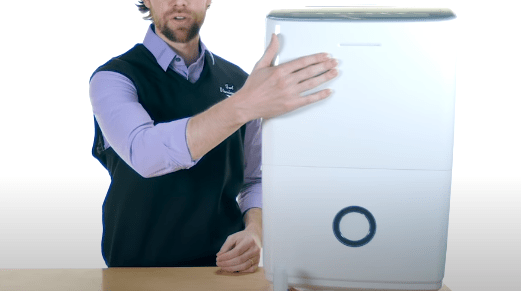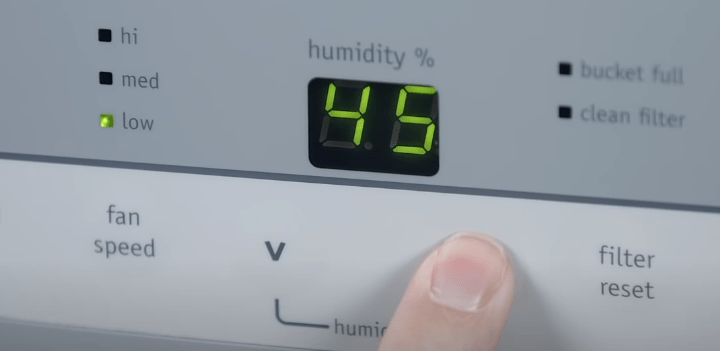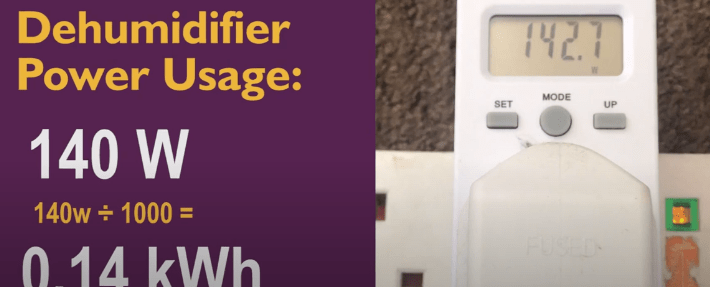Are you tired of battling the relentless humidity, feeling like it’s taking a toll on both your health and your wallet?
Hi, I’m Mannan Wasif, your go-to guide for all things dehumidifiers. Today, we’re diving into a question that might have crossed your mind more than once: how much does it cost to run a dehumidifier 24 hours a day? But before we crunch the numbers, let’s take a moment to connect on a personal level and explore how excessive moisture in your environment can affect your well-being.
Imagine yourself in a home where the air feels heavy and every breath seems like a struggle. Your health is undoubtedly a priority, and so is your comfort. As someone who has been there, I understand the frustration and discomfort that come with high humidity levels.
In this blog post, I’ll not only tackle the financial aspect of running a dehumidifier around the clock but also delve into the ways it can make your living space a healthier and more pleasant one.
Now, let’s embark on this journey together. I’ll uncover the tricks and solutions to the problems that dehumidifiers can solve, starting with the age-old question: What does it truly cost to keep that trusty dehumidifier running day in and day out? Join me as we demystify the numbers and discover how to create a more comfortable, healthier environment for you and your loved ones.
How Much Does It cost to run a dehumidifier 24 hours a day?
In the course of an average day, the operation of a dehumidifier will set you back approximately $2.28. Yet, nailing down an exact figure remains an elusive endeavor due to a medley of influencing variables.
Factors to Consider
Due to the presence of multiple factors affecting pricing, it is impossible to provide a precise answer regarding the 24-hour daily cost of running a dehumidifier. Familiarizing yourself with these factors can assist in estimating your expenses for continuous dehumidifier operation.
1. Dehumidifier Size

The dimensions of your dehumidifier play a leading role in determining electricity consumption. In essence, bigger dehumidifiers, particularly when deployed in spacious rooms, guzzle more power in their relentless pursuit of moisture extraction. While they might take a toll on your electricity bill, they prove their mettle by wringing out copious amounts of moisture.
2. Dehumidifier Efficiency

Not all dehumidifiers are created equal when it comes to energy efficiency. Some models operate like stealthy ninjas, silently performing their moisture-eradicating duties while sipping less electricity. Seek out those adorned with the Energy Star Certification badge, as they are the champions of conservation. These energy-efficient champions boast energy consumption rates that are 15 to 20 percent lower than their run-of-the-mill counterparts.
Intriguingly, energy-efficient dehumidifiers flaunt an integrated energy factor (IEF) ranging from 1.57 to 1.95, with an average of 1.79. Contrast this with standard dehumidifiers, which typically sport an IEF rating between 1.9 and 2.5. Opting for the former may lead to substantial savings in the long run.
3. Cost of Electricity in Your Area

Let’s not forget the pivotal role of geography in this equation. The cost of electricity swings wildly from one region to another, even within the same state or town. The geography of your domicile significantly influences the bottom line of running a dehumidifier 24/7. It’s no secret that electricity rates are mercurial, but fear not, for you can decipher the price tag in your area.
Whether your electric bill proudly displays your area’s electricity rates or you need to perform a little detective work, understanding the cost per kilowatt-hour is pivotal. Armed with this knowledge, you can calculate the precise impact of your dehumidifier’s ceaseless operation.
Approximately 19% of U.S. households utilize dehumidifiers, which can consume over 1,000 kWh of electricity per year, equivalent to twice an ENERGY STAR refrigerator. A 2011 study examined 21 residential dehumidifiers in the Northeast and Mid-Atlantic regions, revealing issues with low efficiency and malfunctioning humidity controls in some units.
Tips for Reducing Dehumidifier Costs
Even if you own a compact dehumidifier or a state-of-the-art energy-efficient model, the truth remains: it shows up on your energy bill, as our earlier estimates revealed. On average, running a dehumidifier sets you back approximately $100 or more annually, excluding miniature versions. But fret not, for there are savvy ways to trim down those costs. Dive into these wallet-friendly strategies:
1. Choose the Right Size
When selecting a dehumidifier, don’t underestimate the importance of size. Pay heed to the unit’s capacity, often denoted by terms like PPD (Pints Per Day) and room coverage. For optimal performance, align these key factors correctly.
Imagine this scenario: you place a modest-sized dehumidifier in a sprawling basement or choose a unit designed for a mere 250 square feet when you’re dealing with a larger space. The result? Your dehumidifier runs tirelessly yet fails to properly dehumidify the air.
The lesson here is to match the dehumidifier’s size to its intended location. Before relocating it from room to room, consider the size of your largest room. By doing so, you’ll ensure that your chosen dehumidifier efficiently covers every nook and cranny.
While the price tag of a 30-pint dehumidifier might lure you, don’t be misled. A 50-pint dehumidifier, despite the initial cost, may triumph in a room of equal size. Why? Because it moves more air, expediting the dehumidification process and allowing for an earlier shutdown.
2. Improve Air Circulation Naturally
Reduce your dependence on a dehumidifier by enhancing natural air circulation within your home. Run ceiling or standing fans for a few minutes daily if you have them. Additionally, crack open a few windows to welcome fresh air into your living space.
In humid indoor environments, inadequate ventilation traps moisture. By introducing fresh air through open windows and circulating it with fans, you facilitate the exchange of water vapor and fresher air.
3. Use Moisture Adsorbers
Moisture adsorbers or desiccants wield remarkable efficiency in moisture removal. While larger units consume electricity, smaller desiccants like the Eva-Dry operate without electricity. They only require recharging when necessary.
Using a moisture absorber complements your dehumidifier’s efforts. It lends a helping hand when the situation demands it, making your dehumidifier work more effectively.
4. Go for Energy-Efficient Dehumidifiers
If you haven’t yet acquired a dehumidifier, consider energy-efficient models. These units often bear the Energy Star Certification, signifying up to 20 percent less energy consumption compared to standard models. Rest assured, the initial cost aligns with regular models.
5. Reduce Humidity
Aside from reducing humidity, implementing these additional tips can further trim energy usage:
- Enhance drainage to prevent excess moisture around your home.
- Tackle leaks promptly to prevent a surge in humidity.
- When using a clothes dryer, ensure proper venting to the outdoors. Alternatively, opt for line-drying.
6. Limit Your Dehumidifier
In colder climates, refrigeration-based dehumidifiers lose efficiency. During chilly months, consider abstaining from their use to prevent energy overuse and potential damage.
For those residing in regions with extended cold seasons, contemplate the use of desiccant dehumidifiers, which eschew compressors and refrigerants.
What’s the total cost of running a dehumidifier?
To determine your monthly dehumidifier operating costs, follow these steps:
- Convert the dehumidifier’s wattage to kilowatts by dividing by 1000.
- Multiply the daily hours of operation by 30 days to get the monthly hours.
- Find the cost per kWh unit from your utility company.
- Calculate the total cost: (Dehumidifier’s power usage in kWh) x (Monthly dehumidifier’s running time) x (Price per kWh unit).
For example, if you run a 920-watt dehumidifier for 24 hours a day over 30 days in Arizona (where the October 2021 kWh rate was $0.1283), your cost would be:
(920 watts/1000) x (24 hours/day x 30 days) x $0.1283 = $84.98592.
For a standard 300-watt dehumidifier running 6 hours daily for 30 days in the same location, the cost would be:
(300 watts/1000) x (24 hours/day x 30 days) x $0.1283 = $6.9282.
The total cost varies based on your dehumidifier’s size, monthly usage duration, and local kWh unit rate.
Importance of maintaining a dehumidifier for 24 hours per day
Maintaining the cost of running a dehumidifier 24 hours a day is essential for several reasons, as it directly impacts your finances and the overall effectiveness of the appliance. Here are some important points to consider:
- Energy Consumption: Dehumidifiers can be significant energy consumers, especially when running continuously. Understanding and managing the cost of running one continuously is crucial to prevent excessive energy bills. This is important for budgeting and reducing your overall energy consumption, which can contribute to a greener and more sustainable lifestyle.
- Cost Control: Continuous operation can result in a substantial increase in electricity costs over time. Monitoring and maintaining these costs help you stay within your budget and make informed decisions about when and how to use the dehumidifier most effectively.
- Appliance Longevity: Running a dehumidifier non-stop without proper maintenance can lead to premature wear and tear. Maintenance costs, such as cleaning filters, checking for refrigerant leaks, and servicing the unit, are important to ensure the appliance’s longevity. Neglecting maintenance can lead to costly repairs or the need for a replacement.
- Environmental Impact: Excessive energy consumption contributes to environmental issues, such as increased carbon emissions and resource depletion. Managing the cost of running your dehumidifier helps reduce your carbon footprint and promotes environmentally responsible behavior.
- Humidity Control: Dehumidifiers are often used to maintain indoor humidity levels within a comfortable and healthy range. By ensuring the cost of continuous operation is manageable, you can better control indoor humidity, which is vital for preventing mold growth, reducing allergens, and enhancing indoor air quality.
- Comfort and Health: Maintaining the cost of running a dehumidifier is crucial for providing a comfortable and healthy living environment. High humidity levels can lead to discomfort, odors, and potential health issues. Properly managing costs allows you to enjoy the benefits of humidity control without overburdening your finances.
- Seasonal Considerations: It’s important to assess whether running the dehumidifier 24/7 is necessary year-round or only during specific seasons or weather conditions. Adjusting its operation based on need can help you optimize costs while still achieving your desired humidity levels.
- Energy Efficiency: Investing in an energy-efficient dehumidifier can help reduce the cost of continuous operation. Look for models with Energy Star certification or high energy efficiency ratings to minimize energy consumption while achieving your humidity control goals.
Conclusion
In conclusion, understanding the cost of running a dehumidifier 24 hours a day is crucial for managing your finances, maintaining appliance longevity, and reducing your environmental impact. By considering factors such as dehumidifier size, efficiency, local electricity rates, and implementing cost-saving strategies, you can strike a balance between comfort and affordability.
Remember to adapt your dehumidifier usage to seasonal needs and invest in energy-efficient models to achieve efficient humidity control while keeping costs in check. With the right approach, you can enjoy a comfortable and healthy indoor environment without breaking the bank.

He is a mechanical engineer & our expert team member with over four years of experience who provides comprehensive and informative guides on various home improvement topics. From DIY projects to professional installations, he strives to give readers the knowledge and tools they need to make informed decisions and successfully complete their home improvement projects.
His goal is to empower homeowners to create the home of their dreams, while also increasing the value and functionality of their property. Whether you’re a first-time homeowner or a seasoned renovator, he has something for everyone.
